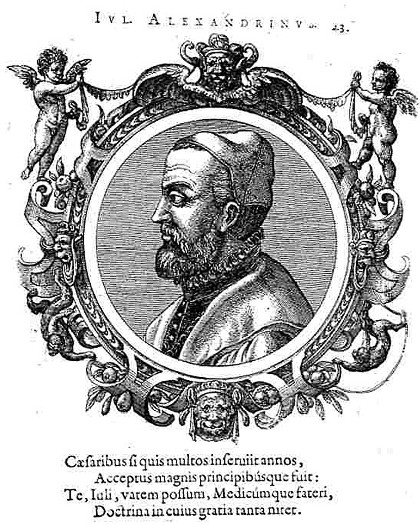Lessico
Iulius Alexandrinus

Icones veterum aliquot ac recentium Medicorum
Philosophorumque
Ioannes Sambucus / János Zsámboky![]()
Antverpiae 1574
Molto verosimilmente era medico alla corte dell’imperatore Ferdinando I d'Asburgo. Lo si puň dedurre da un frammento della biografia di Conrad Gessner che ho trovato nel web: “At the suggestion of the Royal physicians Julius Alexandrinus and Stephan Laurenz Amerfort, Gessner dedicated his work on fish and water animals (1558) to Emperor Ferdinand I, who had just been elected. Ferdinand had expressed to his physicians the desire to meet Gessner. After the dedication, Gessner was invited to a meeting of the Reichstag in 1559, where he met privately with the Emperor for over an hour. At the instigation of Alexandrinus, Amerfort, and Crato von Krafftheim, Gessner was granted a coat of arms in 1564. Gessner tried to get in contact with King Maximilian (1527-1576), who seemed more sympathetic to Protestantism, but he tried to do this through the conman and adventurer Paul Skalic and was not successful. Andreas Szadkowski, a Polish writer on salt mines, was a small time patron. He gave Gessner an amount of money, and dedicated his De rerum fossilium (1565) to Gessner.”
Ferdinando I d'Asburgo
Imperatore (Alcalá de Henares![]() 1503 - Vienna 1564). Fratello minore dell'imperatore Carlo V, che nel 1521 gli
cedette le terre ereditarie asburgiche (in cambio della rinuncia allo
smembramento dei Paesi Bassi) e, nel 1531, il titolo di re dei Romani. Dopo
una lunga collaborazione col fratello, in seguito all'abdicazione di Carlo
ebbe nel 1558 il titolo imperiale.
1503 - Vienna 1564). Fratello minore dell'imperatore Carlo V, che nel 1521 gli
cedette le terre ereditarie asburgiche (in cambio della rinuncia allo
smembramento dei Paesi Bassi) e, nel 1531, il titolo di re dei Romani. Dopo
una lunga collaborazione col fratello, in seguito all'abdicazione di Carlo
ebbe nel 1558 il titolo imperiale.